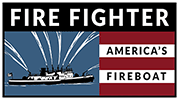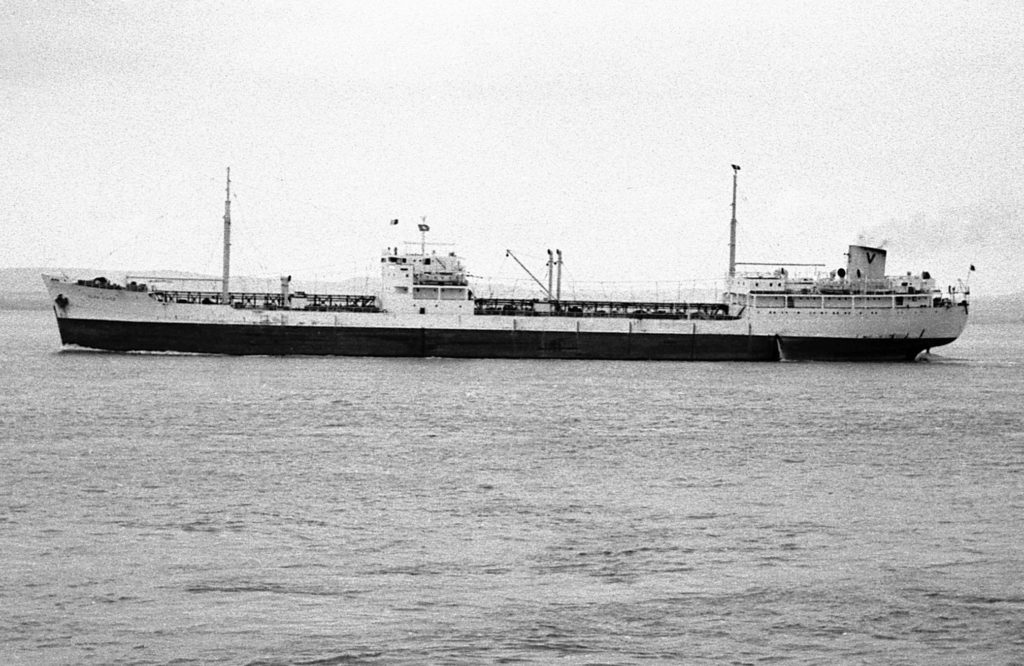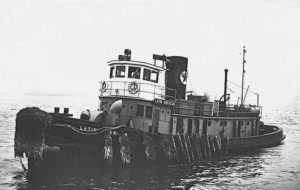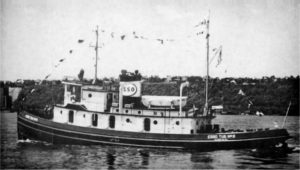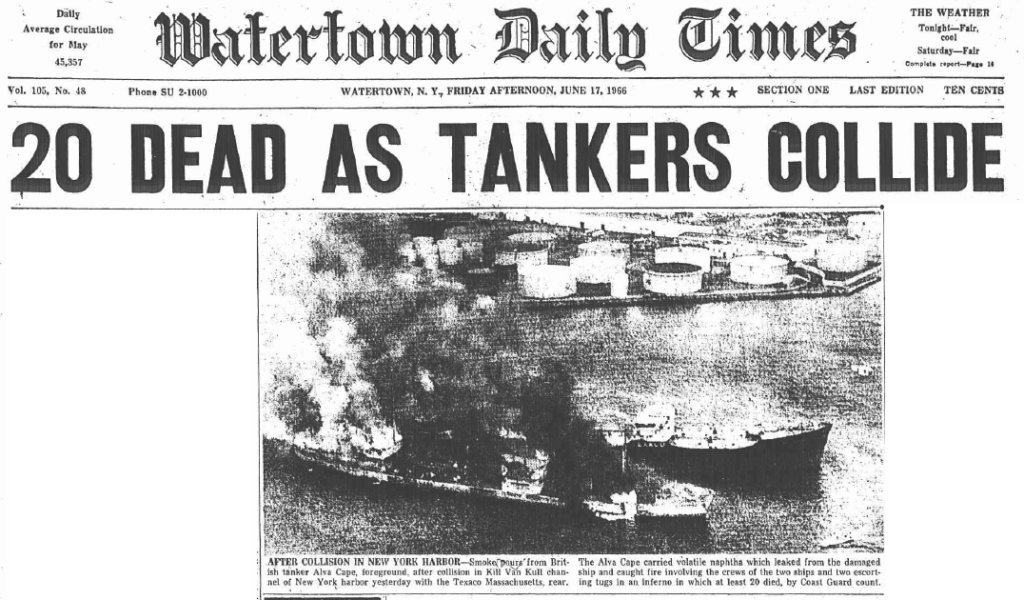Times of slack tide are always busy times in New York Harbor, as the short cessation of the usually ever-present tidal flood and ebb moving into or out of the harbor ceases, making the movement of ships and barges from confined piers and quays much easier for all parties involved. As the afternoon high tide of June 16th, 1966 found it’s way from the Verrazano Narrows into the narrow confines of the Kill van Kull and Newark Bay beyond, it carried with it the usual number of fully laden vessels transiting the shallow waterway from the lower harbor to the bustling quays of Port Elizabeth, while outbound ships awaited their passage so they could ride the slack tide out into the open harbor.
Moving at the rear of the inbound group was the 546ft British-flagged motor tanker Alva Cape which had recently arrived in New York from Karachi, Pakistan and was fully laden with 132,854 barrels of highly flammable Light Virgin Naptha destined for the oil refinery at Bayway, NJ on the Arthur Kill. With a Docking Pilot aboard ship directing her crew through the confines of the Kill, most of the Alva Cape’s remaining on-duty crew were either in her Stern engineering space or topside preparing the ship for docking and offload. Under the escort of the tugboats Esso Massachusetts and Esso Vermont, the ship was nearing the Bayonne Bridge when her pilots hailed the outbound tanker Texaco Massachusetts to confirm their passing arrangements.
Having finalized her delivery of gasoline to the Texaco Bayonne terminal earlier in the day, the tanker Texaco Massachusetts had slipped her lines at Pier 35 and was underway for sea shortly after 1PM, with the tug Latin American made up to her Port bow as escort. Steaming slowly the short distance down Newark Bay towards the Bayonne Bridge as the phalanx of inbound vessels cleared the Kill, the Sandy Hook Pilot aboard the Texaco Massachusetts got in contact with the final vessel moving inbound as his ship neared the critical turning point off Bergen Point.
With the Texaco Massachusetts having the right-of-way in the forthcoming meeting and both pilots seemingly in agreement on how their ships would proceed, the two vessels continued to slowly close on each other at almost 90-degree angles off Bergen Point. At approximately 1:08PM, the Texaco Massachusetts increased speed and began to turn to Port as she started to round Bergen Point, but as she did so the pilot aboard the became increasingly concerned about the rapidly diminishing distance between both ships. After sounding a series of blasts on her horn, the pilot aboard the Texaco Massachusetts ordered the ships engines to full Astern in an attempt to bring the ship to a halt from 3 knots speed. Aboard the Alva Cape, which at 1:08pm was moving at approximately five knots and had just passed beneath the Bayonne Bridge, the docking pilot kept a nervous eye towards the Texaco Massachusetts as she came into full view around Bergen Point. Quickly realizing that there was not enough room for his ship to pass safely astern of the crossing tanker, the pilot ordered Alva Cape’s engine stopped and ordered the Esso Massachusetts to push her bow to Starboard in an effort to comb the approaching ship, however the efforts were for naught. Seeing that a collision was imminent, Alva Cape’s engines were ordered to full Astern and her Starboard anchor dropped shortly before the bow of the high-riding Texaco Massachusetts cut into the Alva Cape on her Starboard hull near the front of her #1 cargo tank and penetrated a full 12ft into the ship before coming to a stop.
Immediately ordering the ships cargo smothering system energized and all firefighting gear broken out, the Master of Alva Cape passed an urgent order to his two escort tugs to seal all doors, portholes and vents and to immediately get clear of his ship, which at this point was starting to turn to the right as her starboard anchor found purchase on the muddy bottom of the Kill. At the same time the engines of the Texaco Massachusetts, still running in full reverse, began to pull the vessel away from the Alva Cape and within two minutes of the initial impact had separated the two ships from each other with a tremendous jolt. With the “plug” now removed from her pierced cargo hold, a large amount of liquid Naptha roiled forth from the Alva Cape and into the waters between the two ships, where it quickly began to gasify. Ordering his engines stopped and sounding the General Alarm aboard his ship, the Master of the Texaco Massacusetts went out on his bridge wing and called to the crew of the tug Latin American to let go of their line and get clear of the area.
Sadly the crew aboard the Latin American were already being overcome by the thick Naptha fumes overspreading their ship, and within two minutes of the initial spill the fumes found their way into the air intakes aboard the tug and into her engine, sending it racing to ever-higher RPMs until it lit off the fumes and consumed the tug in a sheet of flames. Fire quickly spread from the Latin American to the water and air surrounding both tankers, setting the Alva Cape afire and causing a heavy Naptha fume detonation that swept the foward decks of both ships with flames and shrapnel that either killed or badly burned every man stationed there. Fire quickly found its to the tug Esso Vermont which had laid-to along side the tankers Starboard bow, and it too was soon completely engulfed in fire both inside and out.
The first official reports of the collision of the Alva Cape and Texaco Massachusetts reached the FDNY Marine Division shortly before 1:30pm local time from the department switchboard on Staten Island, where a call was relayed from a commercial tugboat Captain. With a massive cloud fire-flecked black smoke rising over Bayonne being more than enough to confirm the report of a major fire burning near Bergen Point, the call went out to the crews of Marine 1 aboard the John D. McKean, Marine 8 and their brand-new fireboat Alfred E. Smith and to Marine 2 and the John J. Harvey to respond at once to the scene. Seemingly missing from this dispatch list was Fire Fighter, who despite being the closest assigned unit from her new post at Marine 9 at Staten Island was out of service and covered in scaffolding as her topsides were being painted. This status was not to be long lived however, as the first on-scene reports from a Coast Guard Cutter arriving onscene came over the airwaves and confirmed that a tremendous amount of Naptha was at risk of detonation, and with it the majority of the immediately adjacent tanks of the Texaco Bayonne terminal. Within half an hour of the initial call to the Marine Division, Fire Fighter was stripped of scaffolding and making her top speed through the Kill Van Kull, hot on the heels of the Alfred E. Smith.
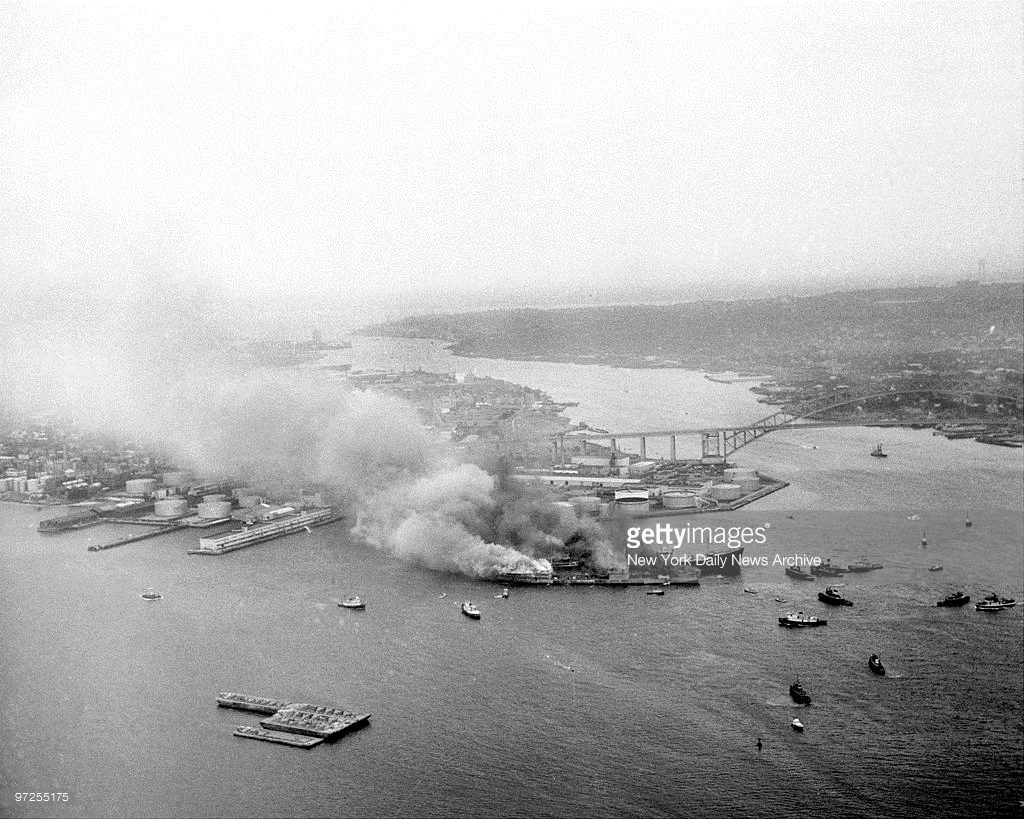
The Alva Cape and Texaco Massachusetts afire near the site of their collision off Bergen Point. A floatilla of rescue craft are present, as well as the John D. McKean on the far right of the photo. The Texaco Bayonne Terminal is in the immediate background. Original pic is courtesy of the NY Daily News

The Alva Cape (left) and Texaco Massachusetts afire with rescue craft and a US Coast Guard HH-52 Seaguard overhead. Original pic is courtesy of the NY Daily News
With the US Coast Guard in command of the rescue effort of the mariners aboard the four vessels involved in the collision and fire, the command of the firefighting effort went to the crew of Marine 1, which moved to and upwind position of the fire and prepared to attack the heavily involved Stern superstructure of the Alva Cape. Joined moments later by the Alfred E. Smith and reports that a helicopter had sighted trapped crew on the bridge wing of the Texaco Massachusetts, the firefighting effort was redirected to providing as much protection to the men as possible as small craft and the helicopter moved in to attempt a rescue.
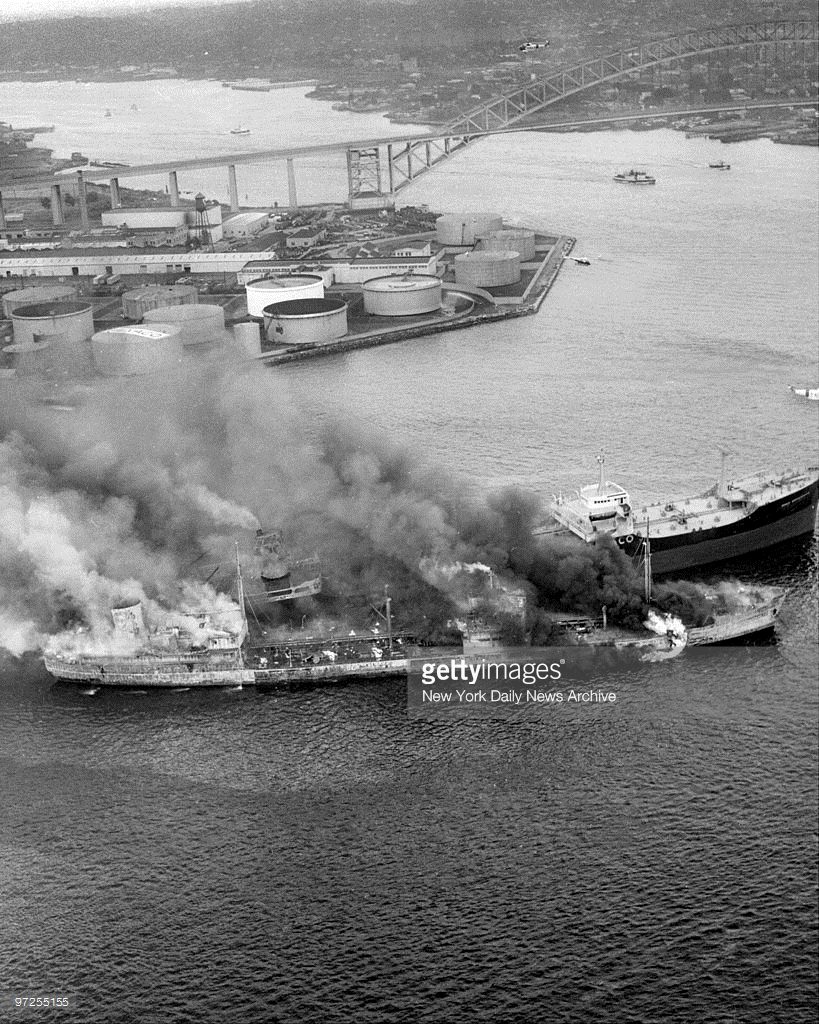
Fire Fighter is visible beneath the Bayonne Bridge as she responds to the scene. Original pic is courtesy of the NY Daily News
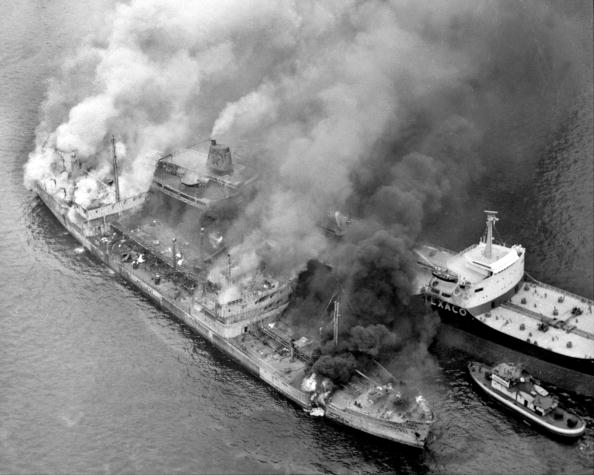
The fireboat Alfred E. Smith maneuvers in between the burning ships in and prepares to lay down a wall of water to aid in the recovery of trapped crewmen aboard the Texaco Massachusetts. Original pic is courtesy of the NY Daily News
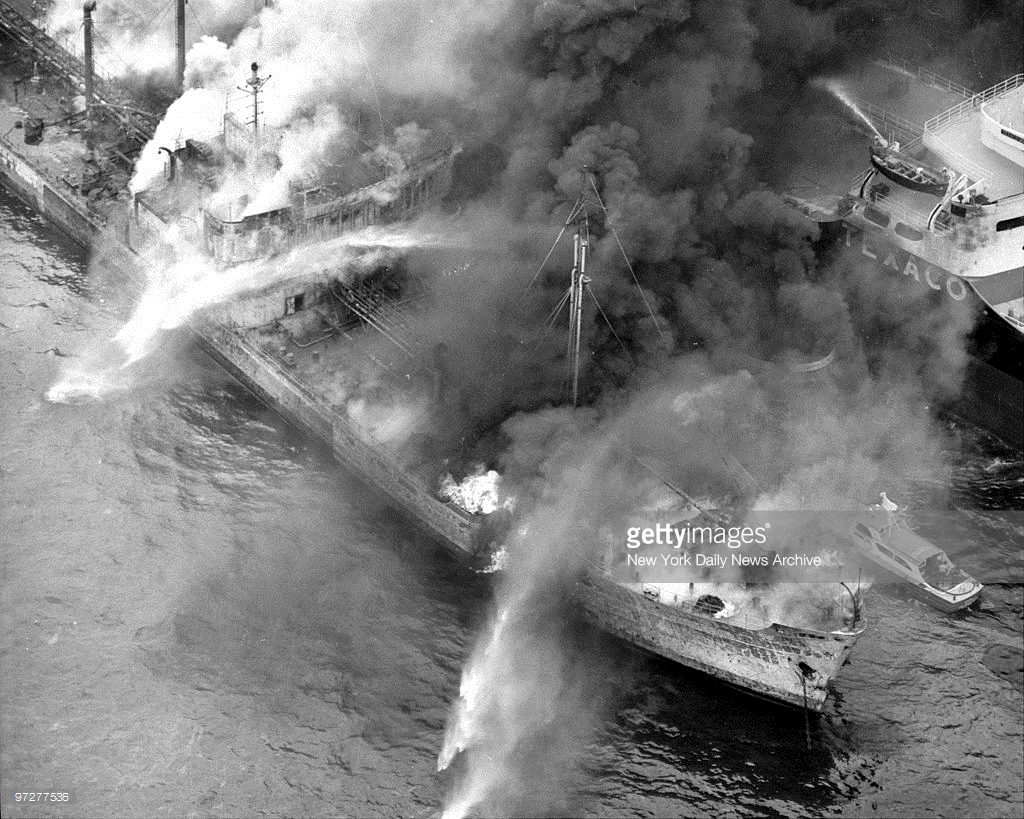
The Alfred E. Smith in the thick of it, followed by the Fireboat Smoke. Moments after this photo was taken, the Smoke backed out and Fire Fighter took her place to provide cover for the Smith. Original pic is courtesy of the NY Daily News
Arriving to orders that she join in the rescue effort of the trapped crewmen, Fire Fighter‘s pilot brought his ship up directly astern of the Smith, which was already in a position roughly equal with the forward superstructure of the Alva Cape and pumping her maximum capacity of 8,000 gallons per minute of water onto the burning ships. Utilizing her topside monitors to create a protective cocoon of water, Fire Fighter enveloped the Smith in spray as she fought the fire and sent a pair of her crew aboard to do a check for survivors aboard the Texaco Massachusetts. With the last visible survivor pulled off both tankers, both the Fighter and Smith withdrew from their perilous location as a pair of commercial tugs took up the anchor line on the Massachusetts and began to tow her clear of the Alva Cape. As the two ships once again separated, responders were horrified to find the severely damaged and fire-ravaged hulls of both the Latin American and Esso Vermont lying alongside the Alva Cape, with no sign of survivors aboard and none likely to be found.
While the Smith and the recently onscene John J. Harvey of Marine 2 set about extinguishing the fires on the two tugs and the Texaco Massachusetts as they were each towed clear, Fire Fighter and the McKean directed their efforts to combating the flames still threatening the remaining cargo aboard the Alva Cape. Joined by the fireboat Smoke which was actively ferrying supplies of foam from shore to shipside, the two fireboats systematically knocked down the flames from her forward superstructure and foredeck, permitting firemen to board the ship and begin flooding the remaining cargo tanks with high-expansion foam to reduce the chance of further cargo catching fire.
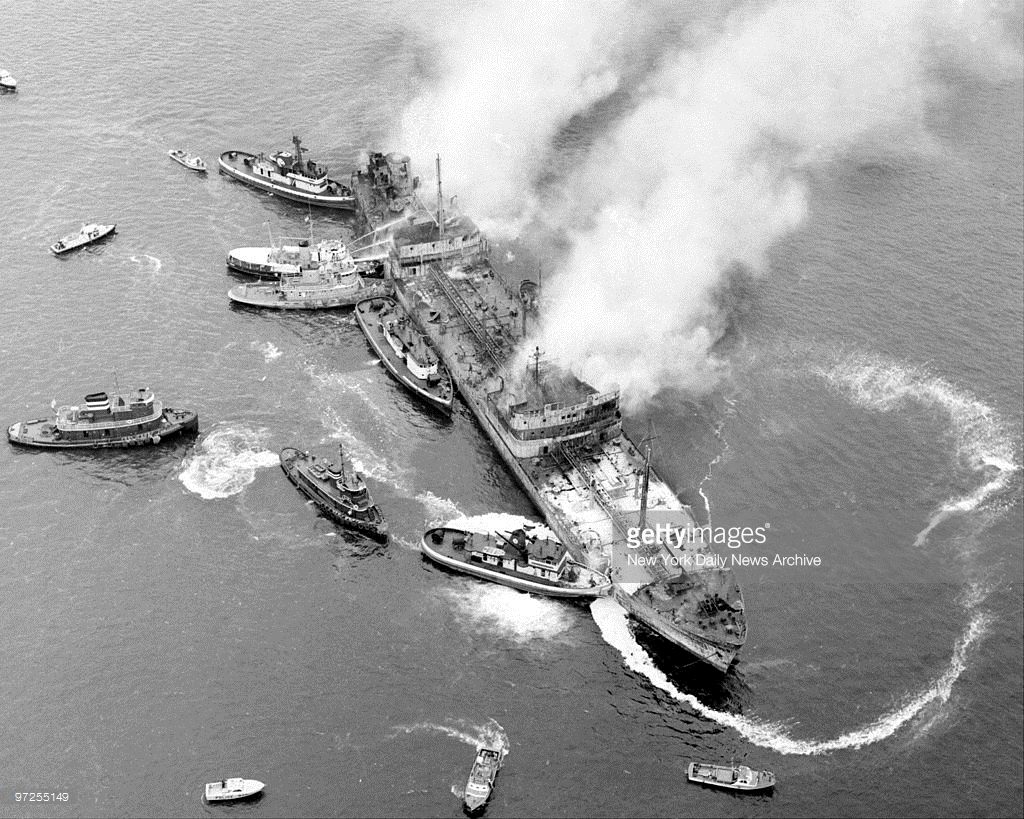
The John D. McKean, a Coast Guard Cutter, a Commercial Tug, Fire Fighter and the Alfred E. Smith all work to knock down the last of the fires aboard the Alva Cape. Note the large amount of Hi-Ex foam on her foredeck and spilling through the hole left by the collision on her Port bow. Original pic is courtesy of the NY Daily News
Thanks to strident efforts by the John J. Harvey, Coast Guard Cutters and commercial Tugs, the fires aboard the Texaco Massachusetts and the Latin American were declared extinguished at 3:25PM, allowing both ships to be towed out of the area. Fires aboard the Esso Vermont proved considerably more stubborn to combat, forcing the tug to be beached on Shooters Island after it began to list dangerously and threaten to sink in the navigation channel. With the ship no longer posing a potential navigation hazard, crews aboard the Harvey had her fires out by 4:55pm and transferred the wreck to the US Coast Guard recovery crews. Now free to focus their efforts on the Alva Cape, the combined efforts of Fire Fighter, Alfred E. Smith and John D. McKean and their crews had the numerous out-of-control fires aboard the Alva Cape under control by 6pm and extinguished at 6:40pm.
With the situation now under control and the threat posed by Alva Cape’s cargo reduced, Marine Units 1 and 9 were released from the scene shortly after dark as recovery crews went aboard to locate any survivors and missing crew aboard the ship. What they found was a similarly grisly scene to what was found aboard the burned-out wrecks of the tugs Latin American and Esso Vermont, and by day’s end the count of lives lost was over 20 and climbing. Of the men from all four vessels who jumped from their ships into the waters of Newark Bay, only those with life jackets survived – a number which favored the crew of the Texaco Massachusetts far more than those aboard Alva Cape. By the time the badly damaged ship had been searched and the remaining cargo in her leaking #1 hold pumped off by salvage crews, the full and terrible toll of the days events had come into focus – 32 mariners had died in the fire; 19 from the Alva Cape, 3 from the Texaco Massachusetts, 4 from the Latin American dead and the entire 8-man crew of the Esso Vermont. A further 13 crew and over a dozen responders were injured, making the events of June 16th, 1966 the worst maritime disaster in New York Harbor since the loss of the General Slocum 62 years prior.
Unfortunately, while the Texaco Massachusetts, Esso Vermont and Latin American were all eventually repaired and returned to service without incident, the Alva Cape would still sow more death and destruction before her time in New York was through. Still partially laden with Naptha, the ship was towed to the designated explosives anchorage in Gravesend Bay on June 20th where salvage efforts were undertaken by the Merritt, Chapman and Scott Corporation under the direction of FDNY personnel aboard the Alfred E. Smith, which was alongside the ship.
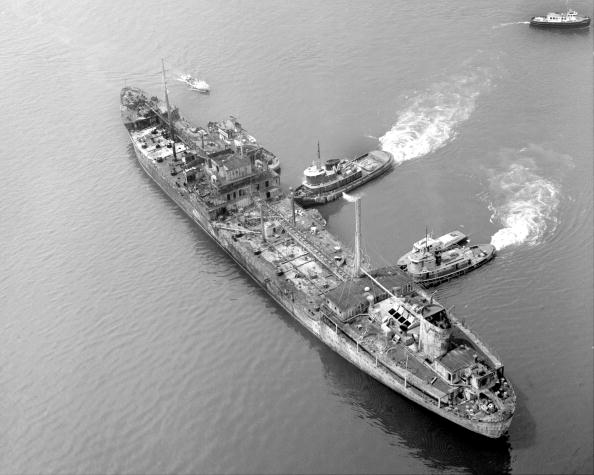
The burned-out wreck of the Alva Cape under salvage in Gravesend Bay shortly before her second explosion. The fireboat Alfred E. Smith is alongside her Starboard Bow. Original pic from the NY Daily News.
After four days of successful offloading, salvage crews were forced to use the ships own pumps to remove the last ~30,000 barrels of Naptha remaining aboard, a task which would require the ships tanks to be sealed and inerted with gas to prevent the risk of an explosion. As this process began in the afternoon of June 28th, a static electric charge built up and set off Naptha vapors in the ship’s #2 hold, resulting in a tremendous overpressure blast and fire that ripped through the fore section of the ship and claimed the lives of four salvage crew. Three subsequent explosions followed, one of which badly damaged the Smith’s superstructure and forced her to cease firefighting operations on the vessel. Once again burning out of control and attended to by Fire Fighter, several Coast Guard Cutters and commercial tugs, the Alva Cape burned for several hours before the flames were brought under control at 4:30pm local time, allowing firemen to board and begin reapplying Hi-Ex foam to her tanks and extinguishing the fire by sundown.
With post-fire inspections revealing that the ships internal structure was severely compromised by heat damage and multiple explosions, the Alva Cape’s owners informed the Captain of the Port of New York on July 1st they were no longer pursuing the salvage of the ship or any cargo remaining on board. With the ship still partially laden with Naptha and now posing a real threat of sinking in the harbor, the ship was ordered towed to sea and scuttled to prevent any further loss of life or damage. Taken under tow by the tug Terry Moran on the morning of June 2nd, the Alva Cape was towed some 110 miles offshore to waters 1,200 fathoms deep and was set adrift in the vicinity of the US Coast Guard Cutter Spencer (WPG-36), which sent over 50 rounds into the derelict tanker and sank her at position 38°55′ N., 72°20.1’W on July 3rd, 1966.
Read the full US Coast Guard Casualty Report on the accident by clicking HERE
